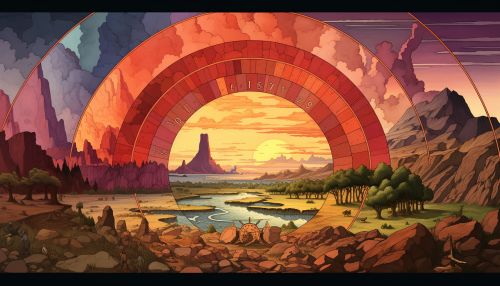Geologic Time Scale
Introduction
The Geologic Time Scale is a system of chronological dating that relates stratigraphic layers to time. It is used by geologists, paleontologists, and other Earth scientists to describe the timing and relationships of events that have occurred during Earth's history. The table of geologic time spans, presented here, agrees with the nomenclature, dates and standard color codes set forth by the International Commission on Stratigraphy.


Precambrian Time
The earliest part of Earth's history, the Precambrian, spans over 88% of Earth's history, and is thus described separately from the Phanerozoic time periods. It is divided into three eons, the Hadean, Archean, and Proterozoic.
Hadean
The Hadean eon represents the time before fossil record of life on Earth; its upper boundary is now regarded as 4.0 Ga (billion years ago). The name "Hadean" comes from Hades, the ancient Greek god of the underworld, in reference to the "hellish" conditions on Earth at the time.
Archean
The Archean eon, which followed the Hadean, extends from 4.0 Ga to 2.5 Ga. During the Archean, the Earth's crust had cooled enough to allow the formation of continents and the beginning of life on Earth.
Proterozoic
The Proterozoic eon, the last in the Precambrian Supereon, lasted from 2.5 Ga to 541 Ma (million years ago). It is further subdivided into the Paleoproterozoic, Mesoproterozoic, and Neoproterozoic eras. The well-identified events of this eon were the rise and proliferation of cyanobacteria and the appearance of the first multicellular organisms.
Phanerozoic Eon
The Phanerozoic Eon is the current eon in the geologic time scale. It covers approximately 541 million years and includes three eras: the Paleozoic, Mesozoic, and Cenozoic.
Paleozoic Era
The Paleozoic Era, which means "ancient life", spans from the end of the Proterozoic Eon 541 Ma to the start of the Mesozoic Era, 252 Ma. It is subdivided into six periods: the Cambrian, Ordovician, Silurian, Devonian, Carboniferous, and Permian.
Mesozoic Era
The Mesozoic Era, also known as "Age of Reptiles", lasted from 252 Ma to 66 Ma. It is divided into three periods: the Triassic, Jurassic, and Cretaceous. This era is most famous for being the time of the dinosaurs.
Cenozoic Era
The Cenozoic Era, also known as "Age of Mammals", spans from 66 Ma to present day. It is divided into three periods: the Paleogene, Neogene, and the Quaternary; and seven epochs: the Paleocene, Eocene, Oligocene, Miocene, Pliocene, Pleistocene, and the Holocene.
Conclusion
The Geologic Time Scale is an essential tool for understanding the history of Earth. It provides a timeline for the billions of years of Earth's past, offering a context for the life forms and geological events that have shaped our planet's history.
